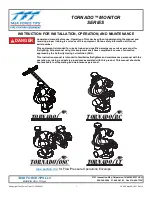
Installation
6
Flow Switch (Optional)
The ports of the flow switch are 3/4 inch NPT Female. The direction of flow is
marked on the casting of the flow tube and on the operating head. Observe
carefully- opposite connection will restrict the water flow and cause load fail-
ure. The flow switch may be connected to the inlet or the outlet side of the
load, preferably as close to the load as possible. Just be certain the flow
through the switch is in the correct direction. Connect with a ½ inch NPT Nip-
ple and a ½ to 3/4 inch bushing, Bird P/N 5-489-1 and 5-490-1, or connect by
hose or pipes. In either case, the flow switch should not be over 20 feet from
the load. Alternatively, attach hose to switch with a 3/4 inch hose nipple, Bird
P/N 5-903.
Do not connect flow switch leads at this time. First turn on the water flow and
check the system for leaks and proper operation.
Control Box (Optional Item)
The wiring center and remaining elements of the control system are contained
in the control box. This includes a terminal strip and three BX cable clamps
for the input connections, a pilot lamp, and a delay timer. Only wiring mate-
rial is needed for connecting the flow switch to the control box. The control
unit operates on 115 Vac, P/N 8750-101-1, or on 230 Vac, P/N 8750-101-2,
depending on the unit ordered to suit requirements.
The pilot lamp on top of the box is a safe operation indicator; it lights only
when AC power is on and an adequate water supply is flowing. After the pilot
lamp lights up, a 12 ±2 second time delay allows sufficient time for the water
flow to stabilize before closing the transmitter interlock.
The control box is mounted by means of four 1/4 inch holes on a 5 x 5 inch
square in the back. Locate the box for the best view of the pilot light and for
easy attachment of the B.S cable and wiring. Connect the leads for each volt-
age as shown on the wiring schematic inside the control box.
Note:
These connections are critical - wire carefully.
Pre-Operational Checkout
Note:
Before attempting to operate the RF load, whether under test
or actual operating conditions, TEST the complete water system and
INTERLOCK CONTROL as follows:
1. Ensure the AC and transmitter interlock power are OFF.
2. Connect an ohmmeter across terminals six and seven (interlock).
3. Turn the AC power on.
4. Turn the water supply on.
5. Note when the water flow switch operates (audible click).
Note:
In not less than 10 seconds (12 ±2) the ohmmeter should sig-
nify a closed condition across terminals six and seven, indicating oper-
ation of the time delay switch.
6. Ensure the water flow from the OUTLET connection of the load is not less
than that given for the respective models.
Note:
As a precautionary measure, it is recommended that the pre-
operational checkout be performed each time the load is put into service.
Summary of Contents for TERMALINE 8745 Series
Page 2: ...I am not blank...
Page 12: ...Introduction 2...
















































